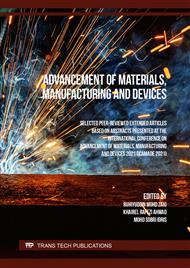[1]
Liu, W., Wang, J., Ke, X., & Li, S. (2017). Large piezoelectric performance of Sn doped BaTiO3 ceramics deviating from quadruple point. Journal of Alloys and Compounds, 712, 1-6.
DOI: 10.1016/j.jallcom.2017.04.013
Google Scholar
[2]
Shi, T., Xie, L., Gu, L., & Zhu, J. (2015). Why Sn doping significantly enhances the dielectric properties of Ba(Ti1-xSnx)O3. Scientific reports, 5(1), 1-4.
DOI: 10.1038/srep08606
Google Scholar
[3]
Veselinović, L., Mitrić, M., Avdeev, M., Marković, S., & Uskoković, D. (2016). New insights into BaTi1–xSnxO3 (0≤ x≤ 0.20) phase diagram from neutron diffraction data. Journal of Applied Crystallography, 49(5), 1726-1733.
DOI: 10.1107/s1600576716013157
Google Scholar
[4]
Li, L., Wang, R., Yu, S., Sun, Z., & Zheng, H. (2018). Novel tin-doped BaTiO3 ceramics with non-reducibility and colossal dielectric constant. Materials Letters, 220, 119-121.
DOI: 10.1016/j.matlet.2018.03.015
Google Scholar
[5]
Surampalli, A., Schiesaro, I., Corsi, P., Meneghini, C., Sathe, V. G., Sagdeo, A., Sinha, A. K., Aquilanti, G., Welter, E. & Reddy, V. R. (2019). Evidence of structural modifications in the region around the broad dielectric maxima in the 30% Sn-doped barium titanate relaxor. Physical Review B, 100(13), 134104.
DOI: 10.1103/physrevb.100.134104
Google Scholar
[6]
Marković, S., Mitrić, M., Cvjetićanin, N., & Uskoković, D. (2007). Preparation and properties of BaTi1−xSnxO3 multilayered ceramics. Journal of the European Ceramic Society, 27(2-3), 505-509.
DOI: 10.1016/j.jeurceramsoc.2006.04.066
Google Scholar
[7]
Kola, L., Murali, D., Pal, S., Nanda, B. R. K., & Murugavel, P. (2019). Enhanced bulk photovoltaic response in Sn doped BaTiO3 through composition dependent structural transformation. Applied Physics Letters, 114(18), 183901.
DOI: 10.1063/1.5088635
Google Scholar
[8]
Selvaraj, M., Venkatesan, R., Mayandi, J., & Venkatachalapathy, V. (2019). Influence of tin (IV) doping on structural and optical properties of rhombohedral barium titanate (BaTiO3). Materials Today: Proceedings.
DOI: 10.1016/j.matpr.2019.05.302
Google Scholar
[9]
Muhsen, K. N. D. K., Osman, R. A. M., & Idris, M. S. (2019). Giant anomalous dielectric behaviour of BaSnO3 at high temperature. Journal of Materials Science: Materials in Electronics, 30(8), 7514-7523.
DOI: 10.1007/s10854-019-01065-x
Google Scholar
[10]
Tomar, R., Pandey, R., Singh, N. B., Gupta, M. K., & Gupta, P. (2020). Electrical properties of barium titanate in presence of Sn2+ dopant. SN Applied Sciences, 2(2), 1-7.
DOI: 10.1007/s42452-020-2017-8
Google Scholar
[11]
Muhsen, K. N. D. K., Osman, R. A. M., Idris, M. S., Jumali, M. H. H., & Jamil, N. H. B. (2019). Enhancing the dielectric properties of (Ba0.85Ca0.15)(SnxZr0.10−xTi0.90)O3 lead-free ceramics by stannum substitution. Journal of Materials Science: Materials in Electronics, 30(23), 20654-20664.
DOI: 10.1007/s10854-019-02431-5
Google Scholar
[12]
Muhsen, K. N. D. K., Osman, R. A. M., & Idris, M. S. (2019). Structure refinement and impedance analysis of Ba0.85Ca0.15Zr0.10Ti0.90O3 ceramics sintered in air and nitrogen. Journal of Materials Science: Materials in Electronics, 30(23), 20673-20686.
DOI: 10.1007/s10854-019-02433-3
Google Scholar
[13]
Muhsen, K. N. D. K., Osman, R. A. M., Idris, M. S., Nadzri, N. I. M., & Jumali, M. H. H. (2021). Effect of sintering temperature on (Ba0.85Ca0.15)(SnxZr0.1-xTi0.9)O3 for piezoelectric energy harvesting applications. Ceramics International, 47(9), 13107-13117.
DOI: 10.1016/j.ceramint.2021.01.175
Google Scholar
[14]
Irvine, J. T., Sinclair, D. C., & West, A. R. (1990). Electroceramics: characterization by impedance spectroscopy. Advanced materials, 2(3), 132-138.
DOI: 10.1002/adma.19900020304
Google Scholar



